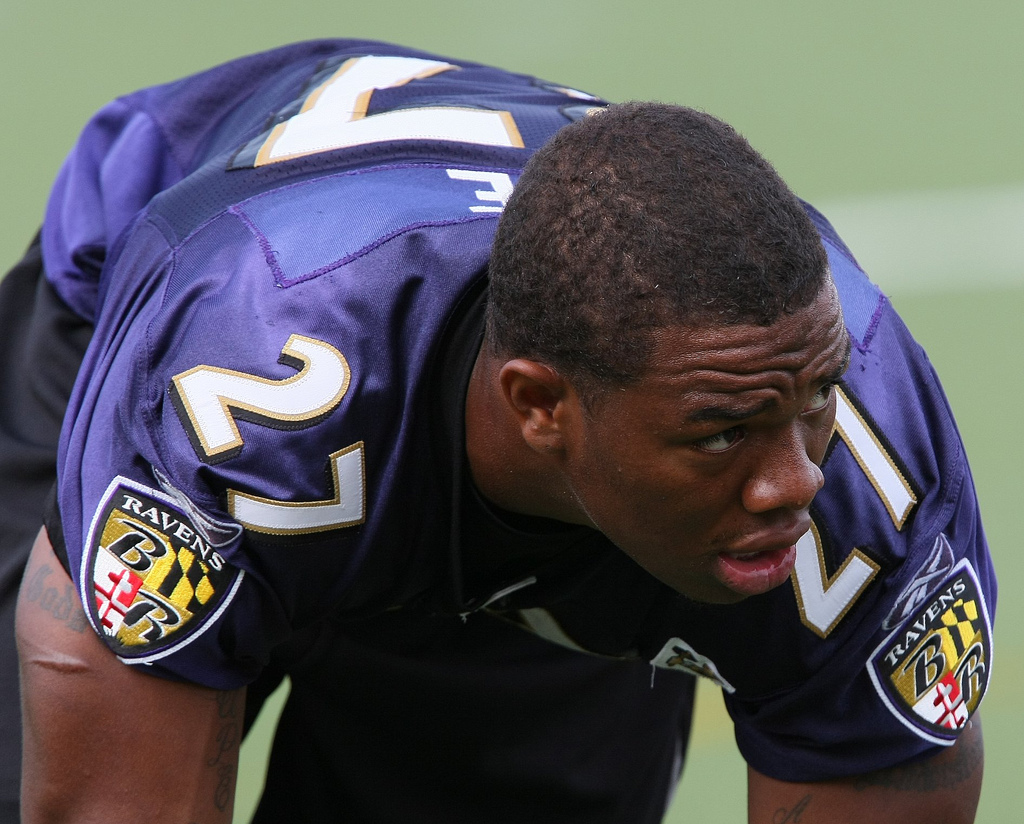Every sport has its demons. Performance enhancing drugs, for example, have riddled the credibility of modern baseball and cycling. Basketball has become a “diva” sport. And recently, football has become the sport most associated with domestic violence. Between endless stories about abusive players and controversy over repercussions and the validity of PR partnerships, the NFL has become a focal point in the budding public discussions about domestic violence.
Ray Rice. Adrian Peterson. Greg Hardy.
When you see these names together, the first thing you may think they have in common is their undeniable talent. But what they also have in common are well-known instances of using physical violence on their loved ones. The cases of these three men have been repeated constantly since they surfaced — so there’s no need to rehash all the gory details (and this isn’t just a figure of speech…the photos and recounts of these incidents is nothing short of grotesque). Interestingly enough, all three of these men received vastly different punishments in terms of how many games they were to miss–Peterson was reinstated after a nearly year-long suspension, Rice reinstated after an initial suspension for two games and then “indefinitely”, and Hardy reinstated after a 10 game suspension had been reduced to four.
The punishments were often incredibly lenient until heinous reminders of the magnitude of these crimes, such as the surfacing of the video of Rice beating his then fiancée unconscious, caused a media uproar that forced that blithering idiot we call Commissioner to publicly increase these sentences. In other cases, such as that of Peterson and Hardy, suspensions were reduced as if the magnitude of the crimes somehow diminished over time.
In August of 2014, the Roger Goodell announced a reformation of the NFL’s domestic violence policy, promising to enforce a six-game suspension for the first offense and a lifetime ban for the second. The NFL partnered with No More, an organization dedicated to ending domestic violence and sexual assault. Commercials aired relentlessly, and powerful, respected NFL figures such as Terry Bradshaw began to voice their public denunciations of NFL members who have committed acts of domestic or sexual violence.
Radio shows, news publications, public figures and civilians alike have lit up airways about these controversies arguing that punishments are too lenient, that these men should not be allowed in the NFL, that the NFL isn’t doing enough; others have applauded the NFL for their “progressive” movement and come out in support of the ability for players to get a second chance. But amidst all of this media hullabaloo, little has been said of charges and punishments concerning domestic violence in other sports. Just as football dodged the mass media attack that descended upon Major League Baseball over steroids and performance enhancing drugs, other sports are relatively silent about domestic violence — as is the media about these sports’ silences.
Here lies the root of the problem about domestic violence: publicity is one sided and criticism, misguided. Rather than attacking the existence of domestic violence, the media and subsequent organizations have been attacking institutions for not punishing perpetrators severely enough. And what’s worse, they have been picking and choosing what groups of people to target.
Domestic violence exists everywhere. Studies have shown that socioeconomic background, race, region and nationality have little to do with increased instances of physical assault on family members. And while it also has been proven that there exists a correlation between athletes of contact sports and incidents of domestic violence, football players aren’t the only public figures that should be scrutinized for domestic violence charges. How scathing will the backlash be against the MLB for the handling of Colorado Rockies shortstop Jose Reyes who was recently arrested for assaulting his wife? How much attention was paid to soccer when goalkeeper Hope Solo was charged twice with domestic violence (because, as we often forget, women are perpetrators also).
Until the media begins to hold everyone accountable for domestic violence, until every major league sport is criticized and scrutinized as heavily as the NFL, the problem will persist.
But a world where Not-Just-the-NFL is put on the hot seat for their poor handling of domestic violence is still just the beginning. What the media has neglected to mention thus far is that by solely attacking the punishments that the NFL is enforcing on these violent players, we as a society are missing the point. The goal is not to drop our moral soap-boxes on Jerry Jones’ head or rail on Roger Goodell for his inability to exemplify the magnitude of domestic violence via punishment. Rather, the goal is to work to prevent domestic violence in the first place.
Enough targeting solely the National Football League.
Enough vilifying the adjudicators in place of the criminals.
If we are to end domestic violence as a society, every sport and every media outlet covering these sports needs to hold every person to a zero tolerance policy that is geared toward psychologically and educationally preventing domestic violence and sexual assault in the first place. The sports community needs to right its wrongs not only by “getting the punishments right” but also by modeling for the rest of the world how a community can eradicate domestic violence once and for all. Because, as the No More campaign aptly stated, “one is too many.”
And the current number is grotesquely higher than one.





